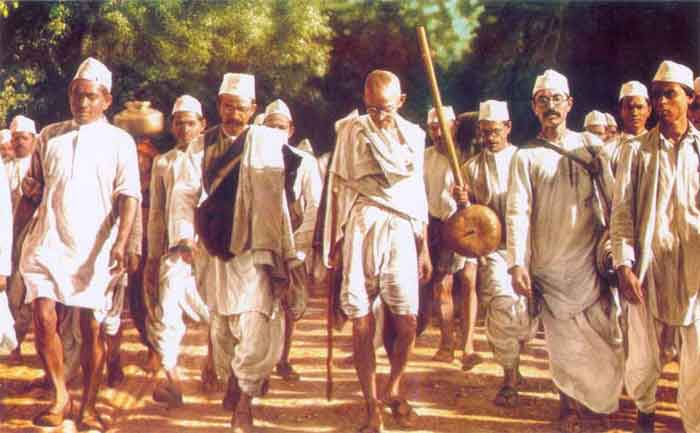The Salt March against Britain
Mohandas Gandhi and Non-violent Salt March
After declaring the Independence of India on January 26, 1930, Mahatma Gandhi reached a turning point in his political efforts to liberate the country from British rule. It became clear that a new anti-government campaign was essential for India’s secularization, but Gandhi was uncertain about the most suitable strategy. During a period of uncertainty, when he saw “no light at the end of the tunnel,” Gandhi realized that non-violent civil disobedience would be the foundation of any upcoming protest.

Mahatma Gandhi’s Salt March, also known as the Dandi March or Salt Satyagraha, was a significant event in the Indian independence movement against British colonial rule. It took place from March 12 to April 6, 1930, and was a pivotal moment in Gandhi’s campaign of nonviolent resistance. The salt tax was one of the many economic injustices used to support British rule. The British held a monopoly on salt in India, making it illegal for anyone other than the British government to sell or produce it. Salt was particularly crucial for the Indian people, many of whom were agricultural laborers, as it was essential for maintaining health in the hot, humid climate. Despite the abundance of salt in India’s coastal areas, laborers were forced to pay for something they could easily collect themselves. Gandhi’s decision to target the salt tax was strategic, as it resonated with all Indians, regardless of region, class, or ethnicity—everyone needed salt, and the British tax on it affected the entire population.
Background of the Salt March
- Salt Tax: The British colonial government imposed a monopoly on the production and sale of salt in India, which included a heavy salt tax. This tax was deeply unpopular because it affected everyone, particularly the poor, who relied on salt for their diet and preservation of food. The British monopoly on salt was seen as an example of their broader economic exploitation and control.
- Economic Impact: The salt tax was not only a financial burden but also a symbol of British oppression. It impacted millions of Indians who were forced to buy expensive, government-controlled salt and was a source of widespread resentment.
The Salt March
- March Details: Gandhi, along with a small group of followers, set out on March 12, 1930, from his ashram in Sabarmati to the coastal village of Dandi in Gujarat. The march covered approximately 240 miles (385 kilometers) and lasted 24 days. During the march, Gandhi and his followers walked about 10 miles (16 kilometers) per day, gaining support and drawing attention to their cause.
- Symbolic Act: Upon reaching the coast on April 6, 1930, Gandhi picked up a lump of natural salt from the shore, symbolically defying British law. This act of civil disobedience was meant to demonstrate the illegitimacy of the salt tax and to encourage Indians to produce their own salt and resist British rule.
Impact and Legacy
- Widespread Support: The Salt March attracted significant national and international attention. It mobilized millions of Indians and galvanized the independence movement, making it one of the most effective acts of civil disobedience in history.
- Arrests and Protests: Following the march, Gandhi and many of his followers were arrested, but the protest continued to spread across India. The British authorities were unable to suppress the growing dissent, and the movement gained momentum.
- Negotiations and Outcomes: The Salt March and the widespread civil disobedience that followed put pressure on the British government. In 1931, Gandhi entered into negotiations with the British, leading to the Gandhi-Irwin Pact, which conceded some of the demands of the Indian nationalists and led to a temporary easing of salt laws.
- Historical Significance: The Salt March remains a powerful symbol of the struggle for justice and nonviolent resistance. It demonstrated the effectiveness of nonviolent protest and became an iconic moment in the struggle for Indian independence. Gandhi’s approach inspired other movements for civil rights and freedom across the world.
Gandhi’s Salt March was a landmark event in the Indian independence movement, highlighting the power of nonviolent resistance and the importance of civil disobedience in challenging unjust laws and colonial rule.
